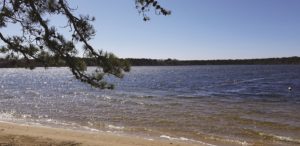EASTHAM — As the municipal drinking water project nears completion, the town is gearing up to tackle its next big infrastructure challenge — what to do with its wastewater.
At a March 21 meeting of the capital projects committee, Health Dept. Director Jane Crowley and project managers Jessica Janney and J. Jefferson Gregg from the engineering consulting firm GHD explained that, to protect its water resources, Eastham will need to put between 300 and 1,400 properties near vulnerable water bodies on sewer systems.
The town will need to choose among five proposed options, which might include putting the majority of homes around Salt Pond, Town Cove, and Nauset Stream on sewers, or combining partial sewering for those neighborhoods with alternative treatment systems.
“To think that we were discharging all our wastewater on the same lot and sucking up our drinking water from the same lot, and that we were able to sustain that for as long as we did is amazing,” Crowley told the Independent, referring to having both wells and septic systems on the same property.
The sustained release of nitrogen into the town’s groundwater has resulted in degraded water quality in both freshwater and saltwater bodies. The total maximum daily load (TMDL) of nitrogen in Salt Pond, Town Cove, and Nauset Stream exceeds the acceptable limit by 4,350 kilograms per year, according to Crowley’s presentation to the capital projects group.

According to the Mass. Estuaries Project, the acceptable TMDL is the “greatest amount of a pollutant that a water body can accept and still meet water quality standards for protecting public health and maintaining the designated beneficial uses of those waters for drinking, swimming, recreation and fishing.” Stormwater and fertilizer both contribute to nitrogen loading, but sewage from thousands of individual cesspools, and even from Title 5 septic systems, is the biggest single culprit, Crowley said.
Depending on its scale, the project could cost between $80 million and $150 million, according to Crowley’s presentation. Four of the five options the town is currently exploring involve placing both a treatment and recharge system at the town-owned lot on Ballwic Avenue behind the Cape Cod Children’s Place. But Town Administrator Jacqui Beebe said at the meeting that she preferred the fifth option, which would have treatment and recharge at the T-Time property or treatment at the transfer station.
This option would involve sewering approximately 900 parcels in the Salt Pond, Nauset Stream, Town Cove, and Nauset Marsh subwatersheds. The consultants estimate that would reduce the annual nitrogen load to those water bodies by 3,750 kilograms. The town has a nitrogen removal goal of 4,355 kilograms per year.
According to a timeline presented during March 21 meeting, planning and design for the sewer project would take place in early 2025, when the project would go out to bid. A timeline for actual installation was not provided.
The town will not rely on sewers alone to reduce nitrogen loading. There are plans to eliminate nearly 968 kilograms annually through various other means. The Cape Cod National Seashore has made one improvement already: the park’s Salt Pond Visitor Center, which uses over one million gallons of water annually, has an advanced treatment system in place. But it was not working properly until last year, Crowley said. The visitor center, which sits atop Salt Pond, now releases 70 percent less nitrogen (a 133 kg/year decrease) than it previously did, she said.
A 200-foot permeable reactive barrier between Salt Pond and Nauset Road has also proved to be effective. The barrier is made of mostly emulsified soybean oil injected into the earth, which prevents nitrogen from contaminating the vulnerable pond.
One of the options under consideration, the fifth option favored by Beebe, would extend the permeable reactive barrier another 1,960 linear feet around Salt Pond, which would reduce the annual nitrogen load by another 549 kilograms.
The town is also working on water quality in its kettle ponds. In a 2019 presentation on the state of the ponds, Liz Moran of EcoLogic LLC deemed five of 11 ponds to be of “declining” quality. “These little kettle ponds are just the groundwater exposing itself,” Crowley told the Independent earlier this month. “There you see a reflection of the bigger picture.”
The town has hydro-raked and aerated Schoolhouse/Minister Pond to remove decaying organic material from the bottom and improve oxygenation and algae issues. “You can really see dramatic effects from that treatment, but it’s usually not a fix,” Crowley said. “You’ve just mitigated the problem. That’s why wastewater and stormwater improvements are so critical.
“Any water you use that goes back into the ground with contaminants in it is wasted water,” Crowley said. “And we need to think about how that affects our resources long term.”



